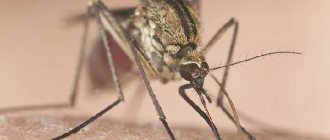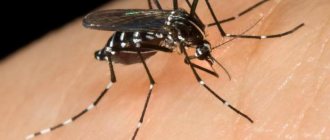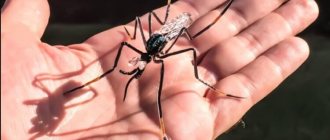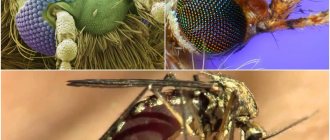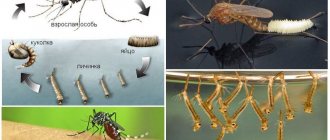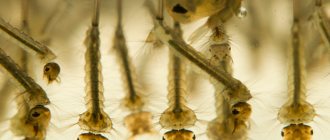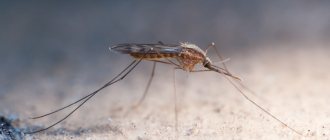Mosquito insect: types, brief description, photo
There are several types of mosquitoes, the most common of which are the following:
- Squeaker. This species is the most numerous. Its peculiarity is that it inhabits almost all corners of the planet. The squeak is small in size, females feed on blood, while males are content with plant food.
- Centipede. The peculiarity of this insect is its size; a mosquito can reach 6-7 cm in length. At the same time, long-legged mosquitoes are absolutely safe for humans and their health.
Mosquitoes
- Tropical mosquito species. This type of insect is distinguished by the fact that it poses a danger not only to health, but also to human life. It is these mosquitoes that carry the most terrible diseases.
- Dergun. The insect got its name because of the constantly twitching long legs that the mosquito puts aside while sitting on any surface. For people, as well as other animals, these representatives of the animal world are harmless.
Description
The common mosquito (in Latin Culex pipiens) is a type of blood-sucking mosquito distributed throughout the globe. Insects are carriers of various diseases of humans (for example, meningitis, Japanese encephalitis, helminthic infestations) and animals (for example, avian malaria).
Mosquitoes are small insects whose size rarely exceeds 7 mm. Female mosquitoes are larger than males, but even their weight rarely reaches 1 g, unless you weigh an individual that has just sucked enough blood.
Appearance
Another name for the insect is the squeak mosquito. The mosquito squeak that irritates people is the sound made by the wings of an insect, which it flaps 500 - 700 times per second. But at the same time, the mosquito’s flight speed is low, the maximum value is about 3.2 km/h. Insects rarely move long distances, preferring to live and hunt in a very limited area.
Attention! The role of mosquitoes in nature is difficult to overestimate. Each generation takes many chemical elements from reservoirs, which subsequently enter the soil with the body of the dead insect, nourishing it. In addition, mosquitoes are an integral part of a large number of food chains.
The common mosquito: where and how long does it live, what does it feed on in the forest, in the swamp?
This insect can also be found under the name “squeak mosquito”. If we talk about the scale on which these bloodsuckers are found, they are truly surprising.
- Squeakers are found throughout Europe. You can also find them in more remote areas of the Earth; they got there during the time of the Great Geographical Discoveries.
- If we talk about the terrain that peepers prefer, it is most often swamps and forests. Bloodsuckers choose this place for a reason, because they love humidity and warmth. It should also be noted that the common mosquito can live anywhere, provided that its food source, that is, a person, is nearby.
Common mosquito
- Regarding the nutrition of these insects, it must be said that only females drink blood, since it is this type of food that they need for procreation. Males prefer plant juices - this is their only food. The females of this insect, both in the forest and in the swamp, in the absence of humans, look for another source of blood. Often the source is other animals: frogs, birds, etc.
- The life of a mosquito is full of various challenges. Its lifespan depends on the environment and temperature at which the bloodsucker is located. It is important to say right away that females live 1.5-2 times longer than males. Generally speaking, females can live from 40 to 120 days, males are correspondingly 2 times less.
How to distinguish a female mosquito from a male: comparison, photo
Almost all animals of the same species differ from each other in the structural features of their bodies, depending on whether they are females or males, and mosquitoes are no exception.
- Mosquitoes have what are called “antennas”. So the main difference lies precisely in them. Males boast lush, thick antennae that resemble whiskers. They need them to hear better. The female does not have such beauty; her antennae are much smaller and practically invisible to the naked eye. In principle, she does not need them, since she does not need hearing, because she is not looking for a partner, but the partner is looking for her.
Female and male
- But the female has a well-developed oral apparatus, with the help of which she can bite the victim and thus provide herself with blood. The male has no need for this - he feeds exclusively on plant foods.
- Also, female squeakers have more developed sensory abilities. They need them to find a donor. As is already clear, male mosquitoes do not possess these abilities, since they do not need donors.
Let us conclude that the structure of the oral apparatus of a mosquito and a mosquito is different. This is due to the fact that the female needs to receive blood for reproduction, and for this she needs to initially bite the victim in order to bite through its skin. The male feeds exclusively on plant foods – plant juice, nectar of different flowers. Its oral apparatus is developed in such a way that it simply has no teeth. Therefore, only mosquitoes bite these insects.
Does a mosquito have a brain, a heart, what organs are there, how many teeth, what does a mosquito squeak, and does it breathe?
Mosquitoes, like any other living creatures, have a certain body structure and internal organs.
- Bloodsuckers have a heart, it is represented by a muscular tube. The blood of these insects is colorless.
- Regarding the brain, it must be said that it also exists. It is represented in mosquitoes by the suprapharyngeal ganglia. They are divided into 3 parts and form the forebrain, midbrain and hindbrain. Each part of the brain performs its own functions.
- Many people wonder whether bloodsuckers have teeth. Mosquitoes have teeth, moreover, they play an incredibly important role in the life of this insect. After all, it is with the help of teeth that a mosquito bites through the donor’s skin. However, they have an unusual appearance for us - prickly bristles. An adult mosquito can have about 50 of them.
Structure of a mosquito
- The insect makes a squeak using nothing other than its wings. Due to the frequent flapping of thin wings, such a sound is formed that is unpleasant to our ears.
- Unlike people, all insects breathe using the trachea, and not the lungs, since they simply do not have the latter. The tracheas of bloodsuckers are represented by tubes through which air passes and which come out on the sides of the body with peculiar openings - spiracles.
- Generally speaking, these insects have a nervous system, oral apparatus, excretory organs, a heart and, accordingly, a circulatory system, genitals, and a respiratory system.
How does a mosquito sleep in the summer, where does it hibernate, and at what temperature does it die?
The activity of a mosquito directly depends on the air temperature where the insect is located. When the temperature drops significantly, for example, at the beginning of autumn, the bloodsuckers disappear, since such a temperature is not suitable for them to reproduce.
- Insects overwinter where they live. Mosquitoes do not fly to another area, country, etc.
- Gaps, cracks in walls, secluded corners, windows, curtains - all these are ideal places for mosquitoes to hibernate.
- Mosquitoes do not disdain various non-residential buildings, such as sheds, garages, etc.
- It is important to note the fact that, in principle, mosquitoes do not need to sleep. If environmental conditions are suitable for it, it will actively continue its activities, reproduce and live.
Optimum temperature for mosquitoes +15-20°C
- High temperatures are more destructive for these insects. The higher the air temperature, the shorter the mosquito's life will be. As for low temperatures, bloodsuckers hibernate at above-zero temperatures, however, if the climate changes slightly and becomes colder, mosquitoes will simply go into their other state - torpor.
- The optimal temperature for the life of these insects is considered to be +15-20°C. It is difficult to say unambiguously what mark on the thermometer will indicate that mosquitoes will die at this temperature. However, temperatures of -7°C and above 28-30°C will have a negative effect on mosquitoes, as a result of which they may die.
Where do mosquitoes come from, how are they born and reproduce?
Initially, during the mating period, males look for their females. The thing is that mosquitoes make a squeaking sound with their wings, it differs from the sound that males make. Moreover, the males of these insects are very selective, since they prefer older females. They also determine the age of a female by the sound her wings make when flying.
- Next, the insects form a kind of swarm, and at this time the fertilization process itself occurs.
- After this, the mosquito begins to actively search for food, however, at this time it is exclusively interested in blood. Having received the required portion of food, the insect lays eggs.
- Larvae emerge from the laid eggs.
Life cycle of a mosquito
- After a certain time, pupae are formed from such larvae.
- In this state, the future insect continues to develop for some time. In just a couple of days, each pupa will mature into a fully viable insect - a mosquito.
Mosquito larvae: what do they look like, what are they called?
Most often, mosquito larvae are called simply larvae, however, sometimes you can find another name - “bloodworm”. By bloodworm we mean the general name for the larvae of these insects, however, it may differ depending on the type of mosquito, etc.
- Bloodsucker larvae, as is already known, emerge from eggs laid by an adult.
- As a rule, mosquitoes lay eggs in damp places, in ponds, and containers with standing water. Accordingly, the larvae live in the same places.
The larva turns into a pupa
- Outwardly, the larva resembles only a small fish or a small worm that has been born.
Blood feeding
It’s not hard to guess what gender the mosquitoes are circling over humans and animals. Males are not interested in this type of food, so they always stay away from humans. The female drinks blood and determines the presence of the prey by the radiated heat and the smell of carbon dioxide, which is released when exhaling.
Female mosquitoes feed on the blood of wild animals in the forest, and on the blood of cattle and humans in rural areas. In the city, the main source of nutrition for females is the blood of people and pets. Whether mosquitoes bite birds was determined in laboratory conditions. Insects bit mice, birds, cats, and dogs. A female weighing 3 mg can eat about 5 mg of blood at a time.
In order for the female to remain near the main source of food for a long time, certain conditions must be met - the presence of places with high humidity for laying eggs. In the wild, these are swamps, areas near rivers, lakes with standing water, and large puddles. There are basements in the city.
On a note!
Females feed on plant foods in addition to blood; the presence of two food sources is the key to a long life - 56 days. In an apartment, insects can find blood for procreation, but they will not find nectar, which is required to replenish their energy reserves. In such conditions, the life expectancy of a female individual is reduced.
How dangerous are mosquitoes, why is it necessary to fight mosquitoes?
By themselves, as animals, mosquitoes, in principle, are not particularly dangerous, however, these insects are carriers of serious illnesses.
- These bloodsuckers are primarily dangerous because they carry diseases such as malaria. It is important to understand that this disease is transmitted only by malaria mosquitoes.
- Also, bloodsuckers can “give” a person, by biting him, various types of fevers.
- In addition, insects are carriers of encephalitis, a serious disease that is very dangerous not only for health, but also for human life.
- Mosquitoes can also carry some infectious diseases.
Folk remedies for mosquitoes
It is quite difficult to get rid of bloodsuckers using traditional methods; they serve more as a deterrent.
The most popular options are to use:
- Spices - they have a rich aroma that mosquitoes cannot tolerate. Cloves, thyme, and rosemary are best suited here. It is recommended to place bags of spices around the entire perimeter of the room;
- Essential oils are a great option for repelling. The most effective oils are citrus fruits, lavender, and cloves. They must be applied to the skin and clothing. Also, the result will be obtained by applying oils along the window opening, in the ventilation shaft.
Can mosquitoes carry diseases, HIV, hepatitis C?
Today you can hear information that these insects are capable of transmitting a disease such as hepatitis. Scientists have conducted a number of studies, their results are as follows:
- It is almost impossible to become infected with this particular disease.
- The viruses of this disease “live” in the blood, and when a mosquito bites its victim, it injects it exclusively with its saliva.
- The insect's mouthparts are designed in such a way that blood can only be sucked inwards, after which the bloodsucker cannot throw it out.
- The same situation occurs with HIV. Moreover, this insect simply will not be able to transmit the required amount of virus to a person for infection.
- Regarding other diseases that were described earlier, things are different. Mosquitoes can easily infect the people they bite with them.
Who gets bitten more by mosquitoes?
Mosquitoes bite more often people with high levels of cholesterol in the blood; they detect it with their senses, and such blood seems more attractive to them. Mosquitoes are also attracted to people with high levels of sex hormones: testosterone in men and estrogen in women. So-called “macho men” are more attractive to mosquitoes than men with less testosterone. Mosquitoes also love obese people with atherosclerosis, due to the same cholesterol. Pregnant women are also attractive prey for mosquitoes due to changes in hormonal levels and increased cholesterol levels in the blood. Before drinking our blood, the mosquito injects its saliva, which contains anticoagulants that prevent blood clotting, into the bite site. Saliva transmits borne infections, such as malaria, yellow fever, dengue fever, some encephalitis, tularemia (present in northern latitudes), etc. Saliva causes unpleasant itching, swelling and redness at the site of the bite, and often an allergic reaction.
Aedes aegypti - vector of yellow fever and dengue fever
What will happen if mosquitoes disappear?
If you think about this issue and try to comprehend it globally, you can come to the conclusion that the complete disappearance of certain species of animals may occur.
- Since mosquitoes are the food of many animals, if they disappear completely, these species will also die out.
- Moreover, these insects will be replaced by others that will multiply even faster and cause even greater harm to nature and humans. For example, various types of midges and ticks.
- We can also say that mosquitoes perform a protective function. It is precisely because these insects have infested the jungles and many forests that this area is not exposed to human influence. The development of these territories by humans will lead to an increase in the population on the planet and, accordingly, to a shortage of all the most important resources.
- In addition to the animal world, the plant world will also suffer, because if these insects are gone, then there will simply be no one to pollinate some flowers and plants.
Malarial, common mosquito, mosquito: comparison, similarities, differences, photos
Many types of mosquitoes are very similar to each other, which is why we often confuse them.
- Malaria mosquito. This insect has fairly long legs and a proboscis. If we compare these insects with ordinary mosquitoes, they have some differences. The legs of the malarial bloodsucker are much longer, as is its proboscis, compared to the limbs of the squeak.
- Mosquitoes are insects that, in principle, are similar to ordinary mosquitoes, however, they differ from the latter in the environment in which they develop and live. The similarity of these bloodsuckers is that they feed not only on plant foods, but also on blood.
- At the same time, malaria mosquitoes and mosquitoes are dangerous for people, because they carry various ailments and infections. While an ordinary squeak does not pose such a danger.
Features of the oral apparatus
The oral apparatus, which allows the mosquito to feed, is distinguished by its piercing-sucking type. It is characterized by a rather complex structure, is located in the lower part of the mouth, and has the shape of a proboscis tube. The sharp stylets of the jaw are also located here.
It is important to understand that a mosquito can be a carrier of dangerous infections - malaria, yellow fever, West Nile fever, tularemia.
A human bite occurs as follows: lowering the proboscis inside the skin to the depth where the capillaries are located. Having cut a hole, the insect can easily suck out the blood.
A mosquito with long legs: what is it called, does it bite?
These insects, which are huge compared to ordinary mosquitoes, instill fear in almost all people. Are they really dangerous?
- This insect is called a caramora or simply a long-legged mosquito .
- These insects are distributed almost everywhere, with the exception of places where it is constantly very cold.
- Regarding the danger that Karamora can bring, the following must be said: it simply does not exist. This mosquito does not have the necessary structure of the oral cavity to carry out any biting actions.
Long-legged mosquito
- The proboscis, which we can see with the naked eye, only gives the insect the opportunity to feed on plant food, and the length and size of the body are just the characteristics of this mosquito.
How many times can the same mosquito bite?
Very often, when an annoying insect circles somewhere nearby, every now and then perching on various parts of the body, an irritated person has a question about how many times a mosquito bites.
Unfortunately, the answer is disappointing - there are no restrictions. The female tries to get the amount of blood she needs at one time. But if something bothers her, she will fly away and then return again and again until she is satisfied. In addition, do not forget that it is almost impossible to distinguish one mosquito from another. Therefore, it may seem to a person that he is being chased by one mosquito, although in fact several individuals fly up to him one by one.
At what altitude do mosquitoes fly, to what floor do they reach?
Sometimes it seems that these squeaking bloodsuckers are simply ubiquitous. Despite the small size of its body, this insect is capable of rising quite high in the air and pestering even residents of high-rise buildings.
- Despite such encounters with mosquitoes, they themselves do not fly too high of their own free will. Mostly these insects rise above the ground only a few meters.
- However, drafts and wind can lift such a small insect much higher than 2-3 m. If we are talking about the presence of these creatures on the upper floors of, for example, a 9-story building, then it is worth saying the following: they get there mainly not through the open air, but through ventilation hatches, etc.
Mosquitoes fly high only when there is wind
- During such flights, the insect rests several times, clinging to surfaces. This is how mosquitoes can reach the highest floors.
- There is information that this insect was found on the 54th floor of the building.
Why doesn't a male mosquito drink blood if it would allow him to live longer?
Indeed, obtaining “building material” for cell renewal could extend the life of an individual. However, during this time the female will simply repeat the reproduction cycle several times and increase her offspring. The primitive metabolism of the male is not designed to process protein food, and the proboscis is not capable of piercing the skin. In this way, the necessary balance is maintained between individuals of different sexes, while saving resources on reproduction. However, a vegetarian diet provides mosquitoes with a fairly long life in terms of the insect world, if all the dangers of the forest are avoided.
Interesting facts about mosquitoes
Despite the fact that few people like mosquitoes, their lives are full of interesting things. And if we consider these insects not as bloodsuckers, then the interest in them will be much stronger.
- Mosquitoes have a unique daily routine. During the day, these creatures rest, hiding not only from the bright rays of the sun, but also from other animals that feed on them.
- There is information that this is exactly the number of mosquitoes – 1,200,000 – needed to drink all the blood from a person.
- Many people do not know the fact that only female mosquitoes drink blood and bite, however, this is true.
- Initially, mosquitoes were called flies, in principle, like all other dipterous insects.
- Mosquitoes are able to smell prey at a distance of several tens of meters.
As you can see, mosquitoes are not only constantly disturbing squeaking creatures. These insects benefit both humans and all living nature. Moreover, the death of these insects will lead to irreversible processes, so it is impossible to deliberately exterminate them.
Choice of victim
Although the insect is small in size, it has an excellently developed level of sensory organs. The entire surface of the body has receptors that recognize the presence of people at a distance of up to 50 meters. If we talk about the fundamental criterion for selecting victims for attack, then the smell captured by the mosquito is taken into account.
A larger number of olfactory receptors are aimed at recognizing substances that are present among the components of lymph, sweat of people and animals. The species Anopheles gambiae, which carries a dangerous disease - malaria, almost constantly chooses humans for food, although it has been proven that the lack of available alternative sources forces the female to attack any victims due to an urgent need for proteins.
Mosquito antennae contain 72 receptors with different purposes.
While searching for a food source, the female pays attention to:
- Carbon dioxide - this compound attracts insects because it is produced by humans and animals during respiration. In addition to this substance, other chemical elements are released, including octenol and acids. Mosquito receptors make it possible to identify them, analyze them, and then select the most preferable victims. Since adults exhale more compounds, they suffer from bites more often than small children. In addition, bloodsuckers love to attack pregnant women, since they differ in the ratio of exhaled components.
- Body aroma. The smell is influenced by bacteria that live near the gonads of people. Sweat is a biological fluid that has a not very pleasant aroma for people, but attracts pests. Because of this, individuals who have been doing heavy work for a long time will be attacked faster than those who have just taken a shower.
- Skin secretions. Mosquitoes are excellent at catching substances contained in skin secretions.
- Blood type - according to research, mosquitoes prefer those with the first group, they try to avoid the second.
- Lactic acid, which is released with sweat and carbon dioxide during breathing.
There are a number of other parameters in relation to which the choice of victim occurs, including body temperature, the movements that a person makes, sometimes even the shade of clothing plays a role. But the key role, of course, is aroma and body fluids.



